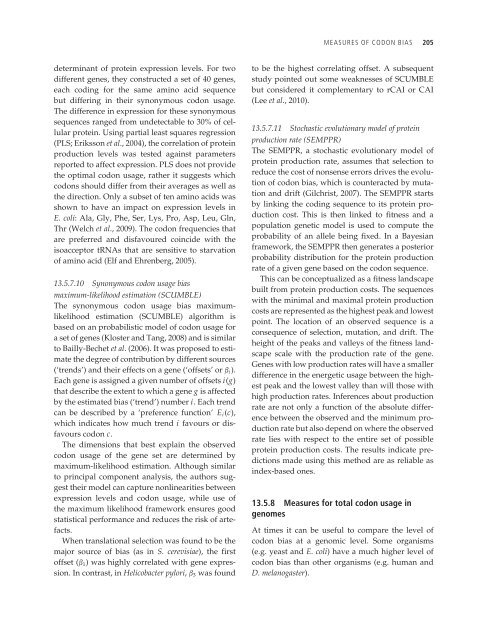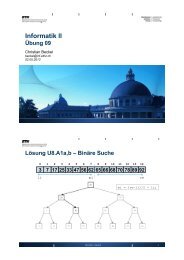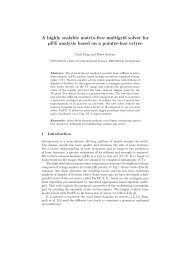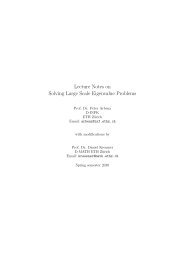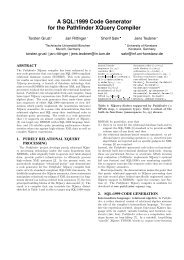Codon Evolution Mechanisms and Models
Codon Evolution Mechanisms and Models
Codon Evolution Mechanisms and Models
Create successful ePaper yourself
Turn your PDF publications into a flip-book with our unique Google optimized e-Paper software.
determinant of protein expression levels. For two<br />
different genes, they constructed a set of 40 genes,<br />
each coding for the same amino acid sequence<br />
but differing in their synonymous codon usage.<br />
The difference in expression for these synonymous<br />
sequences ranged from undetectable to 30% of cellular<br />
protein. Using partial least squares regression<br />
(PLS; Eriksson et al., 2004), the correlation of protein<br />
production levels was tested against parameters<br />
reported to affect expression. PLS does not provide<br />
the optimal codon usage, rather it suggests which<br />
codons should differ from their averages as well as<br />
the direction. Only a subset of ten amino acids was<br />
shown to have an impact on expression levels in<br />
E. coli: Ala,Gly,Phe,Ser,Lys,Pro,Asp,Leu,Gln,<br />
Thr (Welch et al., 2009). The codon frequencies that<br />
are preferred <strong>and</strong> disfavoured coincide with the<br />
isoacceptor tRNAs that are sensitive to starvation<br />
of amino acid (Elf <strong>and</strong> Ehrenberg, 2005).<br />
13.5.7.10 Synonymous codon usage bias<br />
maximum-likelihood estimation (SCUMBLE)<br />
The synonymous codon usage bias maximumlikelihood<br />
estimation (SCUMBLE) algorithm is<br />
based on an probabilistic model of codon usage for<br />
a set of genes (Kloster <strong>and</strong> Tang, 2008) <strong>and</strong> is similar<br />
to Bailly-Bechet et al. (2006). It was proposed to estimate<br />
the degree of contribution by different sources<br />
(‘trends’) <strong>and</strong> their effects on a gene (‘offsets’ or ‚i).<br />
Each gene is assigned a given number of offsets i(g)<br />
that describe the extent to which a gene g is affected<br />
by the estimated bias (‘trend’) number i.Eachtrend<br />
can be described by a ‘preference function’ Ei(c),<br />
which indicates how much trend i favours or disfavours<br />
codon c.<br />
The dimensions that best explain the observed<br />
codon usage of the gene set are determined by<br />
maximum-likelihood estimation. Although similar<br />
to principal component analysis, the authors suggest<br />
their model can capture nonlinearities between<br />
expression levels <strong>and</strong> codon usage, while use of<br />
the maximum likelihood framework ensures good<br />
statistical performance <strong>and</strong> reduces the risk of artefacts.<br />
When translational selection was found to be the<br />
major source of bias (as in S. cerevisiae), the first<br />
offset (‚1) was highly correlated with gene expression.<br />
In contrast, in Helicobacter pylori, ‚3 was found<br />
MEASURES OF CODON BIAS 205<br />
to be the highest correlating offset. A subsequent<br />
study pointed out some weaknesses of SCUMBLE<br />
but considered it complementary to rCAI or CAI<br />
(Lee et al., 2010).<br />
13.5.7.11 Stochastic evolutionary model of protein<br />
production rate (SEMPPR)<br />
The SEMPPR, a stochastic evolutionary model of<br />
protein production rate, assumes that selection to<br />
reduce the cost of nonsense errors drives the evolution<br />
of codon bias, which is counteracted by mutation<br />
<strong>and</strong> drift (Gilchrist, 2007). The SEMPPR starts<br />
by linking the coding sequence to its protein production<br />
cost. This is then linked to fitness <strong>and</strong> a<br />
population genetic model is used to compute the<br />
probability of an allele being fixed. In a Bayesian<br />
framework, the SEMPPR then generates a posterior<br />
probability distribution for the protein production<br />
rate of a given gene based on the codon sequence.<br />
This can be conceptualized as a fitness l<strong>and</strong>scape<br />
built from protein production costs. The sequences<br />
with the minimal <strong>and</strong> maximal protein production<br />
costs are represented as the highest peak <strong>and</strong> lowest<br />
point. The location of an observed sequence is a<br />
consequence of selection, mutation, <strong>and</strong> drift. The<br />
height of the peaks <strong>and</strong> valleys of the fitness l<strong>and</strong>scape<br />
scale with the production rate of the gene.<br />
Genes with low production rates will have a smaller<br />
difference in the energetic usage between the highest<br />
peak <strong>and</strong> the lowest valley than will those with<br />
high production rates. Inferences about production<br />
rate are not only a function of the absolute difference<br />
between the observed <strong>and</strong> the minimum production<br />
rate but also depend on where the observed<br />
rate lies with respect to the entire set of possible<br />
protein production costs. The results indicate predictions<br />
made using this method are as reliable as<br />
index-based ones.<br />
13.5.8 Measures for total codon usage in<br />
genomes<br />
At times it can be useful to compare the level of<br />
codon bias at a genomic level. Some organisms<br />
(e.g. yeast <strong>and</strong> E. coli) have a much higher level of<br />
codon bias than other organisms (e.g. human <strong>and</strong><br />
D. melanogaster).


